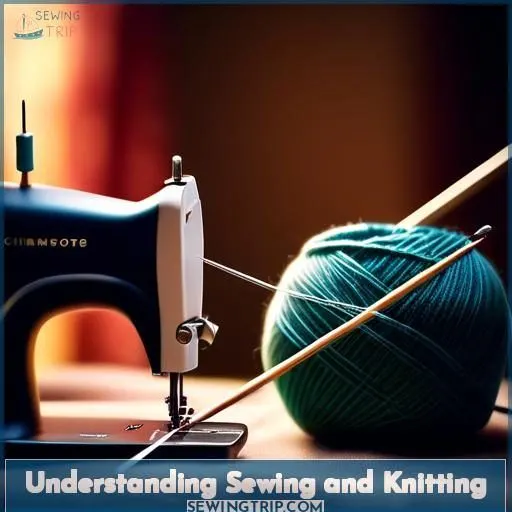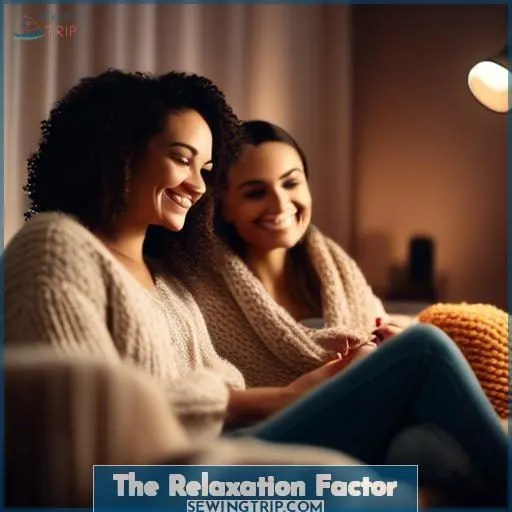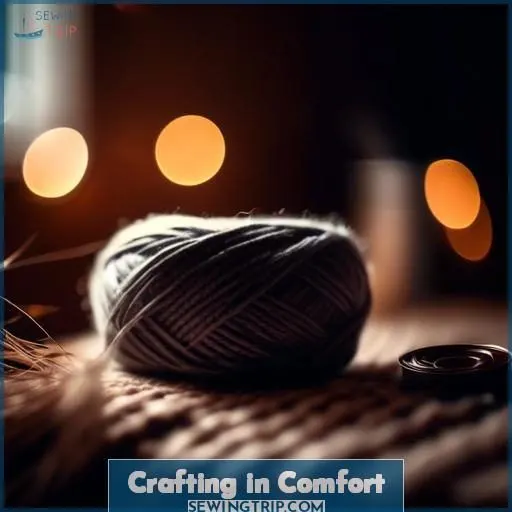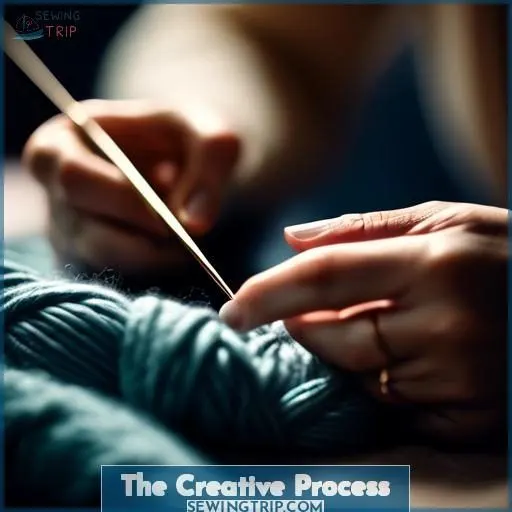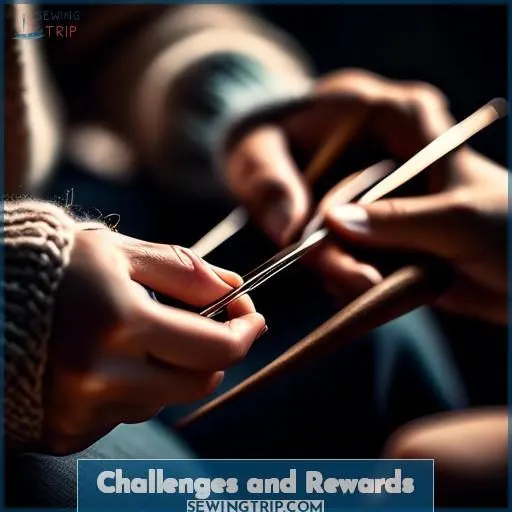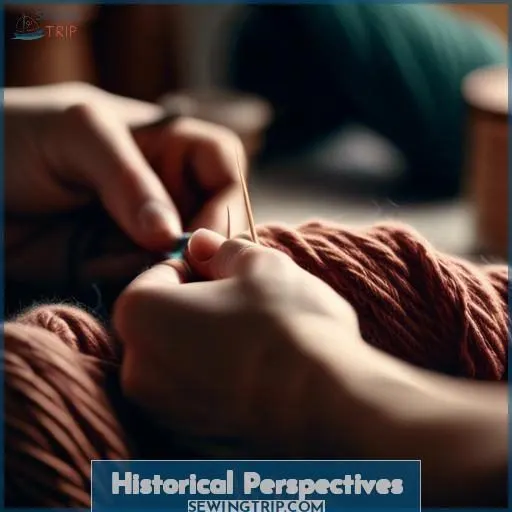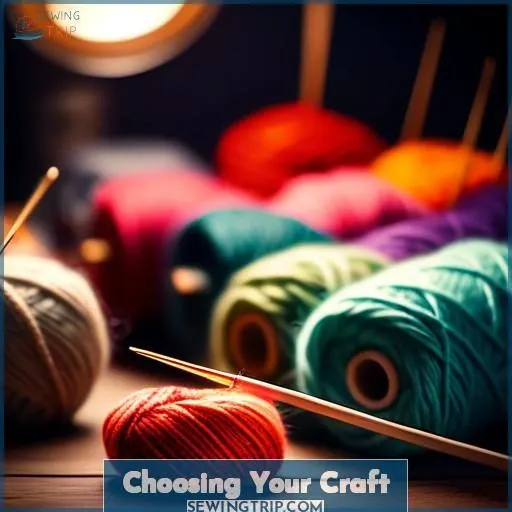This site is supported by our readers. We may earn a commission, at no cost to you, if you purchase through links.
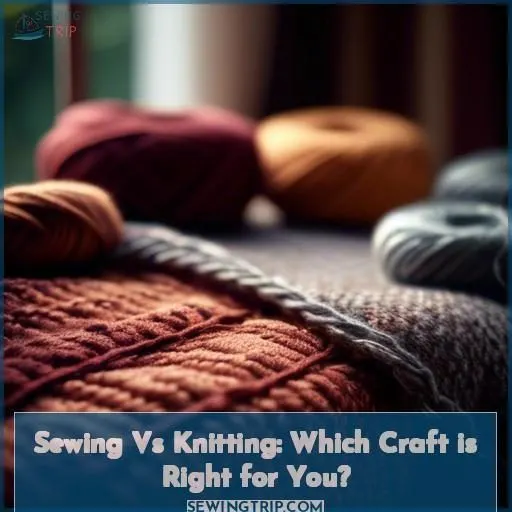 Knitting and sewing are distinct crafts. Sewing entails connecting fabric segments with needle and thread, while knitting produces fabric from yarn using knitting needles.
Knitting and sewing are distinct crafts. Sewing entails connecting fabric segments with needle and thread, while knitting produces fabric from yarn using knitting needles.
Sewing is more exact and custom-fit, whereas knitting is more leisurely and textured. Sewing necessitates more space and order, while knitting is portable and can be done anywhere.
Sewing is concerned with creating structured garments and accessories, while knitting prioritizes warmth and comfort. Both crafts present their unique challenges and rewards.
The selection between them hinges on individual preferences and project objectives.
Table Of Contents
Key Takeaways
- Sewing and knitting are distinct crafts with unique techniques, tools, and materials.
- Sewing involves using a needle and thread to join fabric pieces together, while knitting produces fabric from yarn using knitting needles.
- Sewing is more exact and custom-fit, while knitting is more leisurely and textured.
- The choice between sewing and knitting depends on individual preferences and project objectives.
Is Knitting and Sewing the Same Thing?
No, knitting and sewing aren’t the same thing. While both involve creating textiles, they use different materials (fabric for sewing and yarn for knitting) and different techniques (stitching pieces together for sewing and interlocking loops for knitting). Sewing is typically used for clothing and upholstery, while knitting is often used for warm clothing items and home goods.
Understanding Sewing and Knitting
Sewing and knitting are two distinct crafts with their own unique techniques, tools, and materials. Sewing involves using a needle and thread to join pieces of fabric together. In contrast, knitting involves using yarn and knitting needles to create fabric from scratch.
Understanding the differences between these two crafts can help you decide which one is right for you based on your personal preferences and project goals. Sewing may be better suited for creating garments or home decor items that require precise shaping and tailoring, while knitting may be more suitable for creating items with a more relaxed, textured look, such as sweaters, scarves, and blankets.
Ultimately, both sewing and knitting can be rewarding and fulfilling hobbies, and many people enjoy exploring both crafts to find the one that best suits their interests and skills.
Basic Techniques
Venture into the realm of sewing and knitting, two crafts providing distinct experiences. Sewing entails tracing patterns, determining sizing, and operating briskly, yielding immediate outcomes.
Conversely, knitting, characterized by a more gradual pace and meticulous attention to detail, employs yarn and knitting needles as its primary instruments.
Both crafts possess inherent challenges and gratifications, necessitating an understanding of their fundamentals prior to selecting the most appropriate one.
Tools Required
Regarding tools, sewing and knitting necessitate distinct sets. For sewing, a sewing machine, scissors, pins, and a rotary cutter are essential. Knitting, conversely, requires knitting needles, yarn, and scissors. Note that sewing utilizes fabric and thread, whereas knitting employs yarn and needles.
Embroidery and needlepoint possess their own distinctive tools such as embroidery needles, hoops, and embroidery scissors.
Each craft has its own spatial requirements – sewing frequently requires more space, while knitting can be undertaken anywhere.
Materials Used
Regarding materials, your decision between sewing and knitting hinges on your personal preferences and the project you envision. For sewing, you’ll require a materials list encompassing fabric, thread, and a needle.
Knitting, by contrast, necessitates yarn choices, needle selection, and thread types. If you’re inclined towards deliberate fashion, you may favor working with Brooklyn Tweed or intricate threads for fiber art.
For counted canvas embroidery, you’ll need to select the appropriate materials for your design.
The Relaxation Factor
Sewing’s fast-paced nature might be overwhelming for some, while knitting’s calming motion can be more relaxing. Consider your personal preferences and project goals before choosing between the two crafts.
Sewing’s Fast Pace
Sewing can be a fast-paced craft, especially when you’re trying to create a garment quickly. The frustration of cutting out patterns, figuring out sizing, and dealing with neglected toiles can lead to a sense of impatience. However, it’s important to remember that sewing is a mind-body connection activity, and rushing through the process may not yield the best results.
To counteract the fast pace, consider these tips:
- Take your time: Sewing isn’t a race. Take the time to measure your body correctly, choose the right pattern size, and make any necessary adjustments before cutting into your fabric.
- Mindful sewing: Focus on the process rather than the end result. This can help you enjoy the experience and potentially reduce frustration.
- Learn from your mistakes: View mistakes as opportunities to learn and improve your skills. Each project can bring you closer to creating a well-fitting garment.
- Seek assistance: If you’re struggling with fit or technique, don’t hesitate to ask for help. Online resources, books, and sewing communities can provide valuable guidance.
Knitting’s Calming Motion
Knitting is renowned for its soothing motion, offering a respite from the hectic tempo of sewing. Nonetheless, knitting poses its own set of hurdles, encompassing tension and swatching dilemmas, along with the deliberate pace of garment creation.
The rhythmic nature of knitting may be soothing, but it’s prudent to be mindful of the disparate yarn types and their characteristics when selecting a project.
The cornerstone of a fulfilling knitting journey lies in patience and a receptiveness to learning.
Crafting in Comfort
Knitting’s portability allows you to craft in comfort, while sewing’s space requirements can make it less convenient.
Knitting’s Portability
Knitting’s portability is one of its most appealing aspects. You can knit on the go, making it perfect for travel or commuting. Portable knitting kits are available, complete with needles and yarn, so you’re always ready to knit.
Knitting on a cozy couch is a great way to relax and unwind. Whether you’re at home or away, knitting offers the freedom to create wherever you are.
Sewing’s Space Requirements
Diving into sewing? Brace yourself for the battle against clutter. Your workspace becomes a canvas, but every masterpiece starts with a bit of mess. Organization is your ally, keeping the noise of scattered supplies at bay. Remember, amidst the chaos of fabric mountains and thread jungles, there’s a rhythm to the madness. Embrace it, and let your creativity flow.
The Creative Process
Sewing and knitting are two distinct crafts, each with its own unique creative process. Sewing is all about structure, allowing you to create precise garments and home decor items, while knitting is more about warmth, providing a comforting, calming experience.
Sewing for Structure
Sewing is a craft that allows you to create structured garments and accessories. The process begins with pattern selection, where you choose the design that best suits your needs. Once you have your pattern, you move on to fabric choice. The type of fabric you use will greatly impact the structure of your project. For instance, heavy fabrics like denim or canvas provide more support, while lighter fabrics like chiffon add softness and drapeability.
After selecting your pattern and fabric, it’s time to focus on garment fitting. This is where you make sure that the pattern pieces match up correctly and that the garment will fit you well. If necessary, you may need to make adjustments to the pattern pieces or the fabric to achieve the desired fit.
Once your pattern and fabric are ready, you can start sewing. Sewing machines require regular maintenance to make sure they function properly. This includes cleaning the machine, maintaining the belts, and keeping the tension consistent. Seam finishing is also an important part of the sewing process. Techniques like French seams, Hong Kong finishes, or serged edges can help prevent fraying and guarantee a clean, professional finish.
Knitting for Warmth
Knitting for Warmth (The Creative Process):
As you explore the realm of knitting, savor the comfort it offers. Experiment with different yarn textures and seasonal stitches to create cozy garments. Layering knitted pieces is a delightful way to display your creativity. Inspiration for patterns is limitless, ranging from timeless sweaters to intricate shawls. With each stitch, you’ll discover joy in the process, not just the final product.
Challenges and Rewards
Sewing demands precision, while knitting tests your patience.
Sewing’s Precision
Sewing’s precision requirements can be a challenge, but also a rewarding experience. Here are three aspects that highlight the importance of precision in sewing:
- Pattern Accuracy: Ensuring patterns are accurately cut and pinned is vital for a well-fitting garment.
- Measurement Importance: Accurate measurements are essential for creating patterns and ensuring a flawless fit.
- Fabric Selection and Thread Quality: Choosing the appropriate fabric and thread quality can make a substantial difference in the final product’s appearance and durability.
Knitting’s Patience Test
Knitting can be a patience-testing craft, particularly when it comes to swatching and addressing tension concerns. Swatching is a fundamental step in knitting that helps guarantee correct sizing and fit, as well as providing information about yarn characteristics and stitch patterns. It can be a lengthy process, but it’s essential for the successful completion of a project.
Tension issues can also be frustrating, with irregular tension causing noticeable variations in the width of the project and the appearance of the stitches. This can result in garments that are either too tight or too loose, which can be challenging to rectify once the project is finished.
Despite these difficulties, knitting can be a rewarding experience. The deliberate, meticulous nature of the craft can be soothing and therapeutic, and the satisfaction of creating a garment can be fulfilling, even if the process is painstakingly slow. The act of knitting can also be relaxing, and the craft can be practiced in a variety of settings, including in bed.
Historical Perspectives
Sewing and knitting are two distinct crafts with unique historical perspectives. Sewing has a long history of being associated with domesticity and femininity, with its origins dating back to ancient civilizations. Knitting has a rich tradition that originated in Egypt around 1000 AD and is believed to have descended from the fishing technique of knotting.
Both crafts have evolved over time. Sewing has become less necessary for survival and more of a hobby. Knitting has maintained its popularity and even experienced a resurgence in recent years.
Understanding the historical context of these crafts can help you decide which one is right for you based on your personal preferences and project goals.
Sewing’s Evolution
Sewing has a deep and captivating history that stretches across centuries. It’s one of the most ancient textile arts, with proof tracing back to the Paleolithic era, around 4000 BC. Early humans utilized bone needles and plant fibers to piece together animal hides, creating rudimentary clothing and shelter. Through time, sewing methods progressed, with the development of metal needles and threads made from organic materials like sinew and plant fibers.
The Middle Ages witnessed the emergence of custom-made clothing, with sewing guilds forming to vouch for the quality of workmanship, provide training for apprentices, and oversee the industry. During the Renaissance, sewing became more intricate and detailed, with the art of embroidery blossoming.
The Industrial Revolution signified a pivotal moment in sewing history with the invention of the sewing machine in the 19th century. The first sewing machine was conceptualized by Barthélemy Thimonnier in 1830, albeit it wasn’t a commercial triumph due to resistance from tailors who feared job loss. Elias Howe’s sewing machine, patented in 1846, was the first viable machine, employing a lockstitch design.
In the 20th century, sewing machines became more widely available and affordable, with entrepreneurs like Isaac Merritt Singer manufacturing and selling machines that markedly reduced the time required to create garments. Today, sewing is a popular pastime and craft, with a vast array of tools, fabrics, and techniques accessible to enthusiasts.
Sewing hasn’t solely provided raiment and shelter but has also acted as a form of artistic expression. From hand-sewn garments to sophisticated machinery in the contemporary textile industry, sewing has progressed and adjusted to fulfill the evolving needs of societies throughout the ages.
Knitting’s Rich Traditions
Knitting has a rich history, with traditions that span centuries and cultures. Here are four ways knitting has made a significant impact:
- Yarn Selection: Knitting has a long history of using various yarns, from silk to wool, and even cotton and linen. The choice of yarn can greatly influence the texture, warmth, and durability of the final product, making it a versatile craft.
- Pattern Complexity: Knitting has evolved from simple stitch patterns to intricate designs, including colorwork and lace. This complexity has allowed knitters to create unique and visually stunning pieces, showcasing their skill and creativity.
- Cultural Significance: Knitting has been a part of many cultures, from ancient Egypt to modern-day Norway. It has been used for both practical purposes, such as warmth and protection, and for artistic expression, with patterns and techniques reflecting the specific culture.
- Therapeutic Benefits: Knitting has been found to have numerous health benefits, including stress relief, improved focus, and even pain reduction. This therapeutic aspect has made knitting a popular hobby for people seeking relaxation and mental well-being.
Choosing Your Craft
In the realm of choosing between sewing and knitting, personal inclinations and project aspirations hold great sway. Should you derive pleasure from working with patterns and fashioning structured garments, sewing may be your ideal path. Conversely, if you seek a more tranquil and expressive experience, knitting could be your calling.
Personal Preferences
Discovering the craft that suits your personal style and preferences can be a rewarding journey. Sewing and knitting both offer unique experiences, but they cater to different needs. If you enjoy a fast-paced work environment and immediate results, sewing might be your choice. On the other hand, knitting is perfect for those who seek a more relaxed, meditative experience with a slower pace and a sense of achievement that comes from creating something intricate.
When it comes to personal style, sewing allows for a wide range of projects, from clothing to home decor, giving you the freedom to express your creativity in various forms. Knitting, on the other hand, is often associated with warmth and comfort, making it a popular choice for creating cozy items like scarves, blankets, and sweaters.
The learning curve in sewing can be steep, especially for beginners, but the satisfaction of mastering a new skill can be a significant motivator. Knitting, on the other hand, is often seen as a more accessible craft due to its simpler techniques and the ability to learn on the go.
In terms of therapeutic benefits, both crafts can provide stress relief and promote relaxation. Sewing has been linked to meditation-like states, while knitting is known for its calming, rhythmic movements that can help reduce anxiety.
Ultimately, the choice between sewing and knitting depends on your personal preferences, whether you value the structure and precision of sewing or the warmth and comfort of knitting.
Project Goals
When choosing between sewing and knitting, consider your project goals. If you’re on a tight budget, sewing can be a cost-effective way to create clothes, home decor, or even gifts. However, it may require more time and space.
On the other hand, knitting can be a more accessible craft that’s less space-intensive, but it might demand more patience and finances for materials.
Consider your aesthetic preferences and social connections too, as sewing can be a more social activity, while knitting can be a solitary pursuit.
Conclusion
While both knitting and sewing are textile crafts, they aren’t the same thing. Sewing involves connecting fabric pieces with a needle and thread, while knitting produces fabric from yarn using knitting needles. Sewing is more exact and custom-fit, while knitting is more leisurely and textured. The choice between them depends on individual preferences and project objectives.

